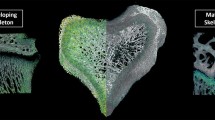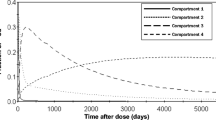Abstract
Rats were given22Na intraperitoneally and the retention of the isotope was determined in whole body and in bone for periods up to 650 days. In contrast to45Ca, which is rapidly taken up by bone and then very slowly released, most of the22Na taken up by bone leaves, with a halftime of 3–5.5 days. However, about 5% of the skeletal burden exhibits a very slow turnover, with a half-time of about 700 days. Since this rate is comparable to that of45Ca, it is concluded that this small fraction of bone Na is an integral part of the crystal structure.
Only two of the several experimental procedures which were tried produced a significant effect on bone Na turnover. These were prolonged feeding of a low calcium diet and a change in parathyroid activity. An increase in dietary Na affected the fast component of bone Na turnover, but there was little if any effect on the slow component.
Calculations from our data suggest that, in contrast to Ca, the skeleton does not serve a significant reservoir function for the support of extracellular fluid Na.
Résumé
Après injection intraperitonéale de22Na, la rétention de l'isotope a été déterminée dans l'organisme entier de rasé et dans leur tissu osseux, pendant une période allant jusqu'à 650 jours. Contrairement au45Ca, qui est rapidement concentré dans l'os, puis lentement éliminé, la presque totalité du22Na absorbée par l'os le quitte avec une demie-période de 3–5.5 jours. Cependant, environ 5% de la charge squelettique présente une vitesse de mobilisation lente, avec une demie-période d'environ 700 jours. Etant donné que cette vitesse est comparable à celle de45Ca, il semble que la faible fraction de Na osseux fasse partie de la structure du cristal.
Seuls deux des procédés expérimentaux utilisés ont un effet significatif sur la mobilisation du Na. Il s'agit de la consommation prolongée d'un régime pauvre en calcium et d'un changement de l'activité parathyroidienne. Une augmentation du Na alimentaire affecte l'augmentation de la vitesse de mobilisation du sodium dans son composé rapide, alors que le composé lent est peu ou pas affecté.
Les calculs effectués, à partir de nos résultats, indiquent que, contrairement au calcium, le squelette ne sert pas de réservoir significatif pour le maintien du milieu liquide extracellulaire.
Zusammenfassung
Ratten erhielten intraperitoneal22Na, und die Retention dieses Isotopes wurde während einer Zeitspanne bis zu 650 Tagen im ganzen Körper und in den Knochen bestimmt. Im Gegensatz zu45Ca, welches sehr rasch von den Knochen aufgenommen und dann nur langsam abgegeben wird, verschwindet der größte Teil des vom Knochen aufgenommenen22Na in einer Halbwertzeit von 3–5,5 Tagen. Jedoch zeigen etwa 5% des Knochengerüstes einen sehr langsamen Turnover mit einer Halbwertzeit von ungefähr 700 Tagen. Da dieser Anteil jenem von45Ca vergleichbar ist, kann daraus geschlossen werden, daß diese kleine Fraktion des Na vom Knochen einen integralen Teil der Kristallstruktur ausmacht.
Nur zwei der verschiedenen experimentellen Anordnungen, welche ausprobiert wurden, ergaben eine signifikante Wirkung auf den Na-Turnover im Knochen. Diese bestanden einerseits aus einer langzeitigen Verfütterung von Ca-armer Diät, andererseits aus einer Veränderung der Parathyreoidea-Aktivität. Eine Erhöhung der Na in der Nahrung beeinflußte die schnelle Komponente des Na-Turnover im Knochen; sie zeigte aber wenig bis keine Wirkung auf die langsame Komponente. Berechnungen aus unseren Resultaten lassen vermuten, daß — im Gegensatz zum Ca — das Skelet keine signifikante Reservoir-Funktion zur Erhaltung des Na in der extracellulären Flüssigkeit ausübt.
Similar content being viewed by others
References
Bryant, F. J., and J. F. Loutit: The entry of strontium-90 into human bone. Proc. roy. Soc. B159, 449–465 (1964).
Burday, S. Z., W. Hecht, and G. B. Forbes: Response of cartilage sodium to changes in extracellular fluid. Proc. Soc. exp. Biol. Med. (N. Y.)105, 137–139 (1960).
Domanski, T. M., D. Depczyk, and J. Liniecki: A test of the theory of alkaline earth metabolism by the behavior of137Ba in rats. Phys. Med. Biol.11, 461–470 (1966).
Forbes, G. B.: Bone sodium and Na22 exchange: relation to water content. Proc. Soc. exp. Biol. (N. Y.)102, 248–250 (1959).
—: Studies on sodium in bone. J. Pediat.56, 180–190 (1960).
—: A 4 pi plastic scintillation detector, Internat. J. Appl. Rad. and Isotopes19, 535–539 (1968).
—, and S. Breibart: Response of bone sodium to acute changes in serum sodium: effect of age. Proc. Soc. exp. Biol. (N. Y.)108, 697–700 (1961).
—, and A. McCoord: Bone sodium as a function of serum sodium in rats. Amer. J. Physiol.209, 830–834 (1965a).
— R. B. Tobin, A. Harrison, and A. McCoord: Effect of acute hypernatremia, hyponatremia, and acidosis on bone sodium. Amer. J. Physiol.209, 825–829 (1965b).
Jeffrey, H., and H. R. Bayne: Bone resorption and Ca45 turnover in growing rats. Amer. J. Physiol.200, 335–340 (1961).
Kaye, S. V.: Distribution and retention of orally administered radiotungsten in the rat. Hlth Phys.15, 399–418 (1968).
Kellerman, G. M.: Retention of Na22 in rat bone. Nature (Lond.)181, 914–915 (1958).
Kshirsager, S. G., Lloyd, E., and Vaughan, J.: Discrimination between strontium and calcium in bone and the transfer from blood to bone in the rabbit. Brit. J. Radiol.39, 131–140 (1966).
Marshall, J. H.: Theory of alkaline earth metabolism. J. theor. Biol.6, 386–412 (1964).
Miller, H., D. S. Munro, and G. M. Wilson: The human use of22Na. Lancet1957 I, 734.
Neuman, W. F., and M. W. Neuman: The chemical dynamics of bone mineral. Chicago: Chicago University Press 1958.
Norris, W. P., S. A. Brues, and A. M. Brues: Retention of radioactive bone seekers. Science128, 456–462 (1958).
Richmond, C. R.: Retention and excretion of radionuclides of the alkali metals by five mammalian species. Los Alamos Reports, LA-2207, pp. 139 (1958).
—, J. E. Furchner, and B. M. Cummins: Effect of age, sodium depletion, and sodium repletion on the retention of sodium22 by rats. J. Nutr.76, 210–214 (1962).
Singer, L., W. D. Armstrong, and M. L. Premer: Skeletal calcium turnover in non-growing rats. Proc. Soc. exp. Biol. (N. Y.)80, 643–646 (1952).
Taylor, D. M.: Retention of Zinc-65 in the bones of rats. Nature (Lond.)189, 932–933 (1961).
Author information
Authors and Affiliations
Additional information
Supported by grants from Atomic Energy Commission and General Support Research Funds of the University of Rochester.
Rights and permissions
About this article
Cite this article
Forbes, G.B., McCoord, A. Long-term behavior of radiosodium in bone: Comparison with radiocalcium and effects of various procedures. Calc. Tis Res. 4, 113–128 (1969). https://doi.org/10.1007/BF02279113
Received:
Issue Date:
DOI: https://doi.org/10.1007/BF02279113




